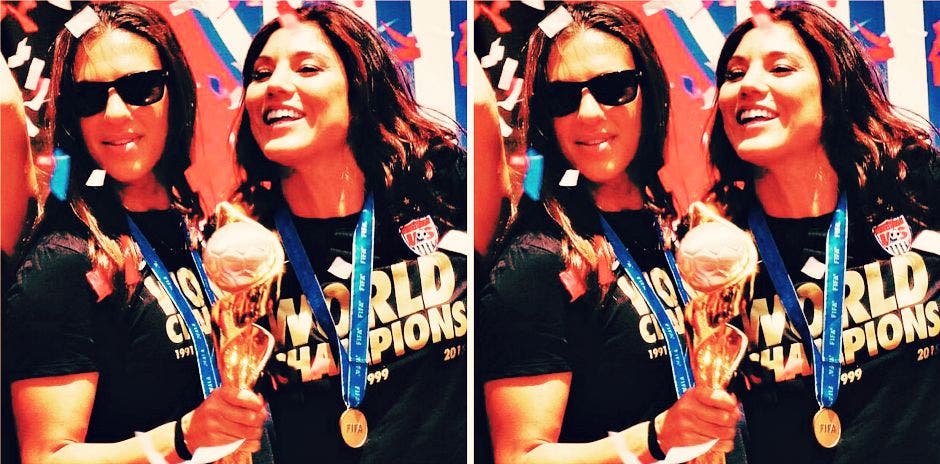The Gender Pay Gap Is Real, And We’re DAMN Tired Of It
Equal pay for equal work STILL doesn't happen in the United States.
 Instagram
Instagram The United States' 5-2 victory over Japan in the FIFA Women’s World Cup final was the most-watched soccer game in United States history. 25.4 million viewers on Fox — a record for any soccer game, men’s or women’s, shown on English-language television in this country — watched the final game.
Despite the fact that the U.S. Women’s team won the tournament, they earned 40 times less than the U.S. Men’s team, who lost in the Round of 16 in the Men’s World Cup. Furthermore, Mary Pilon asserts in a Politico piece that the “total payout for the (winning!) Women's World Cup will be $15 million compared to the (losing!) men's $576 million.”
Clearly, feminism is still needed in the workplace.
Many have taken to Twitter to sound off against such gender disparities in sports, some with sarcastic comments:
Winning women paid less than losing men? Shocking...http://t.co/h0av5UNJnC #payequitynowplease
— Stephanie McNeely (@StefMcNeely) July 6, 2015
Why Don't the Women's World Cup Winners Get Equal Pay? http://t.co/dIoOUhD9PH #FIFAWWC #SheBelieves — FindLaw Consumers (@FindLawConsumer) July 6, 2015
Even U.S. Women’s National Team goalkeeper Hope Solo joined the conversation at the team’s ticker tape parade on Friday, July 10, 2015. (The first women's sports team ever bestowed with a parade, mind you.)
Could not agree more! A photo posted by Hope Solo (@hopesolo) on Jul 7, 2015 at 1:43pm PDT
Pay disparity isn’t anything new in women’s sports, much less in the workplace. President Obama said in his 2014 State of the Union address that women “still make 77 cents for every dollar a man earns,” which is mostly true. According to The Census Bureau in 2012, women who worked full-time year-round made 77 cents for every dollar earned by men, while women in 2013 made about 78 percent of men’s earnings.
To bring attention to the gender pay gap in the United States, on July 7, 2015, The Way Station, a bar in the Prospects Heights neighborhood of Brooklyn, charged women just 77 percent of their bar tab on ladies’ night.
And one more staggering gender pay gap statistic, according to a recent CNN Money piece, the U.S. is 65th in the world on gender pay gap.
The U.S. Women’s win put a spotlight on this gender inequality, but here are some other recent instances of women getting paid less than their male counterparts:
1. Jennifer Lawrence And The Sony Email Leak Saga
Leaked emails from Sony revealed that superstar actress Jennifer Lawrence along with her co-star Amy Adams earned less than their male co-stars for the film American Hustle — even though they were both nominated for Oscars for their roles. This scandal elevated her to the forefront of the Hollywood equal pay debate. After speaking out against Hollywood’s gender pay gap, Lawrence will now earn $20 million, double what her male co-star, Chris Pratt, will take in for Passengers.
2. Amanda Seyfried Experiences The Gender Pay Gap In Hollywood:
Seyfried told the Sunday Times that, “she was paid a 10th of the wage her male co-star received for an unnamed big-budget movie, at a time when both were well-known names in Hollywood.”
3. Hollywood Female Stars Are Paid Way Less Than Men After 34 Years Of Age
According to a study published on January 28, 2014 in the Journal of Management Inquiry, female movie stars peak in their earnings per film at age 34, while their male counterparts peak at 51. Women make more in their 20s than male actors, while male compensation steadily increases over time.
4. Female CEOs At Large Corporations Earn Less
As recently as 2014, women make up just 48 of the CEOs at the country’s 1,000 largest companies, and the median pay for the 11 female CEOs on the list Fortune 500 list is $1.6 million less than median pay for the men.
With all the buzz surround the U.S. Women's Soccer Team's World Cup victory, maybe the critical issue of gender wage gap will finally receive the attention it deserves.

